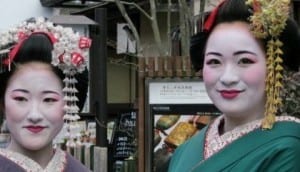First of all,
is it safe to travel to Japan now?
I just returned from a trip to Japan and I am pleased to report that Japan is safe to travel to. Of course it’s advisable to avoid Fukushima, where the earthquake and tsunami struck over a year ago, but the rest of Japan is open for leisure and business.
You cannot discuss Japanese culture without mentioning Kyoto, home of traditional Japanese arts ranging from the tea ceremony and textiles to flower arranging and culinary perfection. The ancient imperial city offers more than Zen temples: Shintu shrines and gardens beckon to visiting foreigners and Japanese alike.
From my first hand experience, here are five original things to do beyond the usual temple visits.
1. See the most expensive dolls a Japanese girl could desire
Learn about traditional doll-making at a third generation master’s studio, The Ando Doll Shop. I saw the traditional elaborately decorated dolls displayed in hotel lobbies and wondered why they are so highly prized. I was not aware how much skill was involved in hand-making the glamorous costumes, hairdos adorned with ornaments and fans, delicate legs, arms, fingers and hand-painted faces. The Ando Doll Shop artisans work for one year to create a single doll. My jaw dropped when I converted the price tags, from yen to dollars, and realized that each doll cost anywhere from $12,000 to over $100,000.00. The dolls are offered by grandparents or parents to newborn girls as wishes for happiness, good health and prosperity. The King of Thailand and the Chinese Premier own Hina dolls made by third generation master Ando Tadahiko, master of the Ando Japanese Doll Shop. Arrange a free tour online at www.ando-doll.com
2. Sample your way through the local market nicknamed “Kyoto’s Kitchen”
Epicureans don’t miss the Nishiki Market. Meander down the narrow, pedestrian street lined with hundreds of food shops and stalls. This is where locals and most of Kyoto’s great chefs buy cooking ingredients.
I have never wandered through such an odor-free fish, fruit and produce market. I could not even identify half of the food items on display. Vendors stand in front of their narrow stalls to offer samples of their fare, from pickles to seaweed soup. Even the fresh seafood market had tantalizing dishes, including tiny octopus heads stuffed with hard-boiled eggs, fish eyes, individually plastic wrapped cod, and whale skin. It is a great place to find knives and cookware, too.
3. Push the buttons on the high tech toilets
Upon arrival in the chilly Osaka Airport I made a bee line for the ladies room. It can be tough enough when you can’t speak or read the language, but it gets even more difficult when you can’t figure out the high tech toilets. I sat down and realized the seat was heated seat. That is only one of many options on the Japanese super toilets. Fascinated with a variety of buttons and pictographs I selected one randomly. An icy jet of water hit my lower back and soaked my blouse and jacket. I didn’t know how to turn it off. I pushed another button and there was a loud sound of flushing – to disguise the noises of bodily functions. Eventually the cold water stopped.
Study the directions before you experiment because most upscale hotels and establishments have super toilets. At one hotel I opened the door, soft lighting and music began, the toilet seat went up and a dispenser sprayed a fragrance into the room. Every toilet promises a new gadget you can try; temperature adjustments for jets of water and bidet-style sprays aimed at sensitive places, a warm blow dryer, volume settings for music or the flushing sound, and remote control. They are a marvel of Japanese technology, so enjoy.
4. Dine in a temple on Zen Buddhist vegetarian cuisine
Head out of the tourist neighborhoods to meet the monks and dine on their ceremonial Fucha cuisine – a distinctive vegetarian fare brought to Japan from China around 1600. Kangaan Temple, once property of Japan’s imperial family, is beautiful at any time, but a private dinner in the evening complete with paper lamps illuminated gardens makes it downright magical. I entered through a stone gate along a path lit by candles which led to the dimly-lit entrance of a Zen temple dominated by an impressive statue of Buddha. Fucha ryouri dishes are made of a seasonal vegetables, mushrooms, sweet potatoes, tofu and wheat gluten, combined in irresistibly appetizing ways. Fucha cuisine is a delicious pinnacle of culinary sophistication and subtlety.
5. Meet “office girls” as make-believe geishas
Although it is rare to glimpse a true Geisha in her silk kimono teetering along the narrow lanes of Kyoto on her high wooden shoes, you may encounter twenty-something young women dressed as Geisha apprentices (called “Maikos”) posing for photos near popular Zen temples. They are pleased to have their photos taken with you and talk a little with foreigners.
I learned that as little girls they played “dress the Geisha” games. To fulfill their fantasy to be a Geisha (or Maiko), they took a day off work, visited a costume shop and rented a kimono, at a cost of more than $200. For several hours they were dressed, coiffured with white makeup on the face, chest and nape of the neck, and styled with hairpieces to create the sophisticated hairdo of a true Geisha.
Shy, elegant and demure, they were having a grand time, and if you stop and talk to them, you too can join in the fun.
In Kyoto young and old alike show appreciation and respect for Japanese culture.